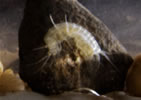Nematoda (Eelworms / Roundworms)
These small unsegmented worms are very common in the soil, water, silt and organic debris of caves, most of them are free-living. They are best seen under a microscope due to their small size. There are many species and identification is difficult - so there are certainly many new species to be found to add to cave species lists. Some are to be found deep in caves.
Nematomorpha (Horsehair worms)
The Nematomorpha have long brown coloured bodies and appear like living pieces of horsehair, hence the name. They are common in surface rivers and streams but have rarely been recorded underground. The different species are difficult to identify.
Annelida (Segmented worms)
The segmented worms (e.g. earthworm) are often abundant in caves, groundwaters and sediments living in soil. They ingest (‘eat’) mud and extract nutrients from it. All those found in caves also live in surface soils and waters. Most of the time they will be hidden in soil and therefore hidden from view, so their importance underground could be underestimated. Both terrestrial and aquatic species are recorded from caves. Species recorded include: Enchytraeus albidus from muddy drainage levels, Tubifex tubifex from White Scar, Eiseniella tetraedra from Stump Cross Caverns, Allolobophora chlorotica from Ingleborough, Sell Gill and Sleets Gill, Lumbricus species, and Dendrobaena veneta from Gaping Ghyll.
The most detailed study on cave dwelling worms has been in Ingleborough Cave where the Green or Stubby Worm Allolobophora chlorotica (the green worm) and the Rosy or Mucous Worm Aporrectodea (=Allolobophora) rosea were found to be the most common in the dark zone. Their worm casts are apparent on the surface of the mudbanks at the end of the show cave. Usually they deposit egested material underground but it is thought the mudbanks may be too compact to allow this so it is left on the surface. In the cave the worms are seen on the surface of the mud and on the rock surface – outside they are rarely seen above the surface. When the soil is saturated the oxygen level is also reduced and worms commonly move to the surface. The cocoons of the worms can hatch under water and the young worms can feed and grow even though they are totally immersed, the worms can survive many weeks in soil under water. Both A. rosea and A. chlorotica are parasitized by the larvae of the cluster fly.
Allolobophora chlorotica has also been found in the mud banks of Robinsons Pot. It is 3-8cm long, with a variable colour: dark green, light green, yellowish green and a pink form Aporrectodea rosea is a similar size (the commonly seen Dew or Lob Worm Lumbricus terrestris is bigger).
|
Pink form of the Green or Stubby Worm Allolobophora chlorotica, Ingleborough Cave |
Casts will be seen on mud banks in other caves e.g. Yordas Cave.
Tubifex sp. worms ingest sediments and gain nutrition by selectively digesting bacteria from the mud and absorbing molecules through the body wall. The worms can survive without oxygen for months, and can survive in areas so heavily polluted with organic matter that almost no other species can survive. T. tubifex can survive drought and food shortage by forming a protective cyst and lowering its metabolic rate. Distinguishing between species is difficult because the reproductive organs, commonly used in species identification, are reabsorbed after mating.
Hirudinea (Leeches)
The leeches are a sub-group of the Annelida. The British species are found in freshwater and include both predatory and parasitic forms, the latter sucking the blood of water birds and mammals. Only one species, the now rare Medicinal Leech Hirudo medicinalis, is capable of penetrating human skin.
|


